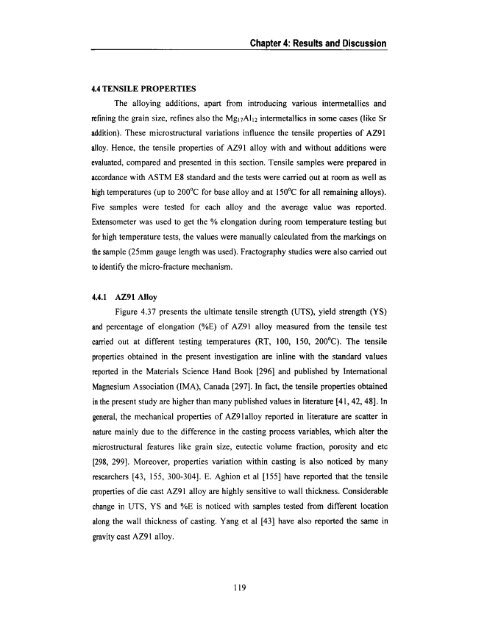“Influence of Si, Sb and Sr Additions on the Microstructure ...
“Influence of Si, Sb and Sr Additions on the Microstructure ...
“Influence of Si, Sb and Sr Additions on the Microstructure ...
You also want an ePaper? Increase the reach of your titles
YUMPU automatically turns print PDFs into web optimized ePapers that Google loves.
[E my g Chapter 4: Results <str<strong>on</strong>g>and</str<strong>on</strong>g> Djscussi<strong>on</strong><br />
4.4 TENSILE PROPERTIES<br />
The alloying additi<strong>on</strong>s, apart from introducing various intermetallics <str<strong>on</strong>g>and</str<strong>on</strong>g><br />
refining <strong>the</strong> grain size, refines also <strong>the</strong> Mg11Al1; intermetallics in some cases (like <str<strong>on</strong>g>Sr</str<strong>on</strong>g><br />
additi<strong>on</strong>). These microstructural variati<strong>on</strong>s influence <strong>the</strong> tensile properties <str<strong>on</strong>g>of</str<strong>on</strong>g> AZ91<br />
alloy. Hence, <strong>the</strong> tensile properties <str<strong>on</strong>g>of</str<strong>on</strong>g> AZ91 alloy with <str<strong>on</strong>g>and</str<strong>on</strong>g> without additi<strong>on</strong>s were<br />
evaluated, compared <str<strong>on</strong>g>and</str<strong>on</strong>g> presented in this secti<strong>on</strong>. Tensile samples were prepared in<br />
accordance with ASTM E8 st<str<strong>on</strong>g>and</str<strong>on</strong>g>ard <str<strong>on</strong>g>and</str<strong>on</strong>g> <strong>the</strong> tests were carried out at room as well as<br />
high temperatures (up to 200°C for base alloy <str<strong>on</strong>g>and</str<strong>on</strong>g> at 1509C for all remaining alloys).<br />
Five samples were tested for each alloy <str<strong>on</strong>g>and</str<strong>on</strong>g> <strong>the</strong> average value was reported.<br />
Extensometer was used to get <strong>the</strong> % el<strong>on</strong>gati<strong>on</strong> during room temperature testing but<br />
for high temperature tests, <strong>the</strong> values were manually calculated from <strong>the</strong> markings <strong>on</strong><br />
<strong>the</strong> sample (25mm gauge length was used). Fractography studies were also carried out<br />
to identify <strong>the</strong> micro-fracture mechanism.<br />
4.4.1 AZ91 Alloy<br />
Figure 4.37 presents <strong>the</strong> ultimate tensile strength (UTS), yield strength (YS)<br />
<str<strong>on</strong>g>and</str<strong>on</strong>g> percentage <str<strong>on</strong>g>of</str<strong>on</strong>g> el<strong>on</strong>gati<strong>on</strong> (%E) <str<strong>on</strong>g>of</str<strong>on</strong>g> AZ91 alloy measured from <strong>the</strong> tensile test<br />
carried out at different testing temperatures (RT, 100, 150, 200°C). The tensile<br />
properties obtained in <strong>the</strong> present investigati<strong>on</strong> are inline with <strong>the</strong> st<str<strong>on</strong>g>and</str<strong>on</strong>g>ard values<br />
reported in <strong>the</strong> Materials Science H<str<strong>on</strong>g>and</str<strong>on</strong>g> Book [296] <str<strong>on</strong>g>and</str<strong>on</strong>g> published by Intemati<strong>on</strong>al<br />
Magnesium Associati<strong>on</strong> (IMA), Canada [297]. In fact, <strong>the</strong> tensile properties obtained<br />
in <strong>the</strong> present study are higher than many published values in literature [41, 42, 48]. In<br />
general, <strong>the</strong> mechanical properties <str<strong>on</strong>g>of</str<strong>on</strong>g> AZ9lalloy reported in literature are scatter in<br />
nature mainly due to <strong>the</strong> difference in <strong>the</strong> casting process variables, which alter <strong>the</strong><br />
microstructural features like grain size, eutectic volume fracti<strong>on</strong>, porosity <str<strong>on</strong>g>and</str<strong>on</strong>g> etc<br />
[298, 299]. Moreover, properties variati<strong>on</strong> within casting is also noticed by many<br />
researchers [43, 155, 300-304]. E. Aghi<strong>on</strong> et al [155] have reported that <strong>the</strong> tensile<br />
properties <str<strong>on</strong>g>of</str<strong>on</strong>g> die cast AZ91 alloy are highly sensitive to wall thickness. C<strong>on</strong>siderable<br />
change in UTS, YS <str<strong>on</strong>g>and</str<strong>on</strong>g> %E is noticed with samples tested from different locati<strong>on</strong><br />
al<strong>on</strong>g <strong>the</strong> wall thickness <str<strong>on</strong>g>of</str<strong>on</strong>g> casting. Yang et al [43] have also reported <strong>the</strong> same in<br />
gravity cast AZ91 alloy.<br />
119
















